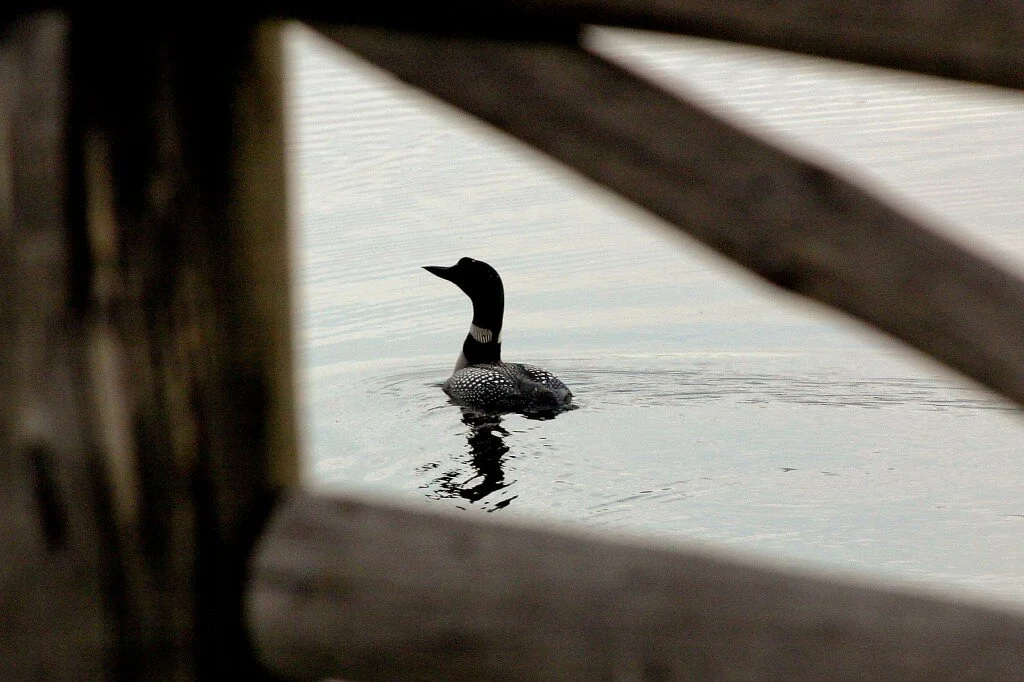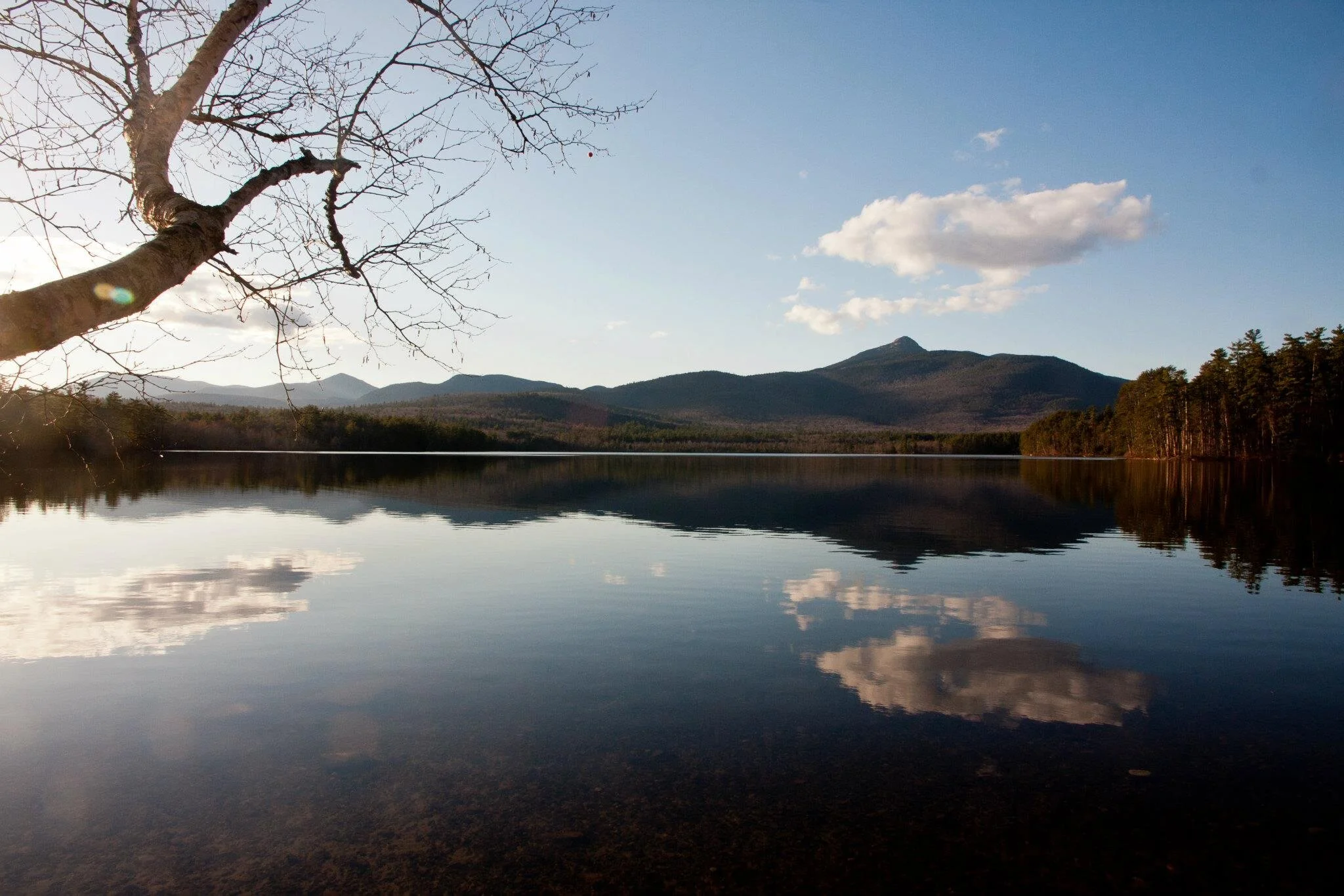A lake is usually classified by scientists as being in one of three possible classes: oligotrophic, mesotrophic or eutrophic.
Water Quality Testing at Chocorua Lake
Loons on Chocorua Lake: 2014 Report
By John Cooley, Biologist, Loon Preservation Committee
Chocorua Lake’s two nesting loons were again successful in 2014, hatching two chicks that survived. This past year continues a long string of successful years of loon reproductive success on the lake. With the exception of 2011, loons have bred successfully on Chocorua Lake in all of the last 15 years, hatching 23 chicks in that time, with 20 surviving.
Loons in Chororua Lake have enjoyed twice the statewide average for reproductive success over the past 15 years, establishing Chocorua Lake as one of a small set of lakes in the state that are core habitat for the loon in New Hampshire, which play a disproportionately large role in the long-term viability of the loon population in the state.
Chocorua Lake is prime loon nesting habitat, but sat vacant – as far as nesting goes—for a quarter century. Although adult loons had been noted on Chocorua Lake since monitoring began in the mid-1970s, almost a decade passed in the 1990s with only intermittent loon presence. Successful nesting on Chocorua Lake wasn’t documented until the year 2000.
The long wait for loons to become an established, successful presence at Chocorua Lake reflects the trajectory of the population as a whole in New Hampshire. From a low point in 1975 with about 100 pairs, this threatened species has slowly reoccupied its historical distribution in the state. New Hampshire now has about 280 pairs of loons across 133 lakes. Loons disperse and colonize a few miles at a time, so the pace of recovery is gradual. But once established, a fit pair of individual loons can live and breed on the same lake for decades, turning it into a powerhouse.
Loons, which are threatened in New Hampshire and protected federally, were hard hit by contaminants and human interaction in the 1970s. The black-and-white birds with the haunting call are still not as plentiful as they once were in New Hampshire. One of the biggest culprits is lead fishing tackle, which accounts for almost half of adult loon deaths every year. A new state law that takes effect in 2016 bans lead sinkers smaller than 1 ounce; the birds are able to ingest the smaller jigs, which can kill them in two to four weeks.
The loons on Chocorua Lake had excellent help this summer from the first annual Save the Loons Fishing Tournament, organized by 13-year old Ryan Buchanan and his family and friends. The contest attracted an enthusiastic crew of anglers to the Grove. The Narrows Bridge next to the Grove is a popular fishing spot, and this was a perfect place to promote safe angling. Providing loon-friendly non-lead tackle and information on loons, the event was a wonderful success. Proceeds benefited the Loon Preservation Committee.
The fishing tournament is a great counterpoint to 2006, when LPC staff collected a dead adult male loon at the Narrows Bridge that had been poisoned by a lead fishing sinker. Such efforts are exactly what is needed to turn the tide and prevent lead poisoning in loons and other wildlife, which is currently the biggest impediment to the continued recovery of loons throughout the state. A huge thanks to Ryan and family for leading the way!
The Loon Protection Committee wishes to acknowledge the generous help of Chocorua community member Rachel Page in finding a home with us for the truly valuable resource of some of the extensive scientific journal collection of the late Malcolm Coulter. As a local but renowned ornithologist, LPC staff knew Malcolm and admired his work, and are grateful to benefit from (and glad to share with interested borrowers) the journal titles that Rachel has provided to LPC. Many thanks, and good memories of Malcolm.
LPC is also extremely grateful for the help of Chocorua Lake resident Alice Waylett and other loon watchers who have kept a close eye on loon activity on the lake over the years and are often our first notice of the spring return, the beginning of nesting, and other important events in the loon season.
Things You Can Do Help Protect Loons
View loons from a respectful distance of at least 200 feet. Do not approach nests, individual adults, or loon chicks.
Don't fish next to a loon. Loons can mistake lures and jigs for their live prey items. Every year loons die from swallowing lures and entanglement in fishing line.
Use non-lead fishing tackle. Loons, eagles, swans, and other waterbirds die from ingesting lead fishing tackle. They ingest the tackle when they eat fish that have tackle left inside by anglers or when they pick up pebbles (or in this case, sinkers or jig heads that look like pebbles) to aid with digestion. Small sinkers and jigs seem to be the biggest problem, and only one lead sinker will kill a loon from lead poisoning.
Spread the word about these issues to your family, guests, neighbors, and other visitors to the lake.
More About Lead Sinkers
Lead fishing tackle was responsible for 49% of documented New Hampshire adult loon mortalities from 1989-2011. In 2000, legislation took effect in New Hampshire to restrict the use in lakes and ponds of lead sinkers weighing one ounce or less, and lead-headed jigs measuring less than one inch in length (including the hook).
Subsequent legislation to restrict the use of these tackle in all freshwater in New Hampshire took effect in 2005, and the sale of these tackle was restricted beginning in 2006. Analysis comparing pre- and post-restriction periods (1989-1999 vs. 2000-2011) found that the rate of lead fishing tackle mortalities in New Hampshire loons fell subsequent to these restrictions; however, this reduction has not been large enough to protect New Hampshire's loon population, and recently (2006-2011) rates of lead tackle mortalities have begun to rise once again.
Climate Change Effects on NH Winters
Dam Repairs Complete
Wildlife Sightings in the Chocorua Basin
Chocorua Lake Conservancy is Formed
2012 Chocorua Lake Water Quality Report Now Available!
2011 Chocorua Lake Water Quality Report Now Available!
Renovation of "The Grove"
The view of Mt Chocorua from the “Grove”, a piece of private property situated between the Big and Little Chocorua Lakes, has become an icon of scenic beauty for New Hampshire and indeed the Nation. The site attracts tens of thousands of visitors a year who come to enjoy the beauty of the spot, to swim, fish, picnic, and launch non-motorized water craft. The Grove had, however, become badly worn over the years due to the heavy foot traffic it receives. Shoreline erosion, root exposure and soil compaction around the base of the tall pines was threatening the very reason why so many people to by this scenic landmark.
To address this problem, members of the Chocorua Lake Conservation Foundation (CLCF) and the Chocorua Lake Association (CLA) got together and wrote two grant proposals to the New Hampshire Moose Plate Program. One was funded in 2008 for a total of $30,000 and the second in 2009 for $23,128. This money was used to hire a landscape designer (Zachary Berger Associates), a tree and plant specialist (P. C. Hoag and Co.) and an engineering firm that specializes in shoreline stabilization (Certified Erosion Control – NH).
Work to restore the beauty of the Grove began in the fall of 2008 is now about complete. The initial work included the development of a landscape plan and the obtaining of a Wetland Permit from both the New Hampshire Department of Environmental Services and the Town of Tamworth.
Planting of new vegetation to better define walking areas began in the fall of 2008 and has continued into the spring of 2009. In addition, use of a new technology (Filtrerxx socks) has been employed to stabilize the shore. Many large boulders have also been set in place to provide sitting areas for visitors and to help direct people along pathways to the water.
It is realized, however, that this restoration effort is just the beginning of an ongoing effort to maintain the Grove’s intrinsic beauty.
Conditions in the Grove will have to be monitored regularly to include the removal of nonnative weeds from the newly planted areas, the watering of the new vegetation, the addition of mulch to reduce soil compaction and,most of all, the education of the public as to the fragile nature of site and the work that is being done to preserve it for future generations.







